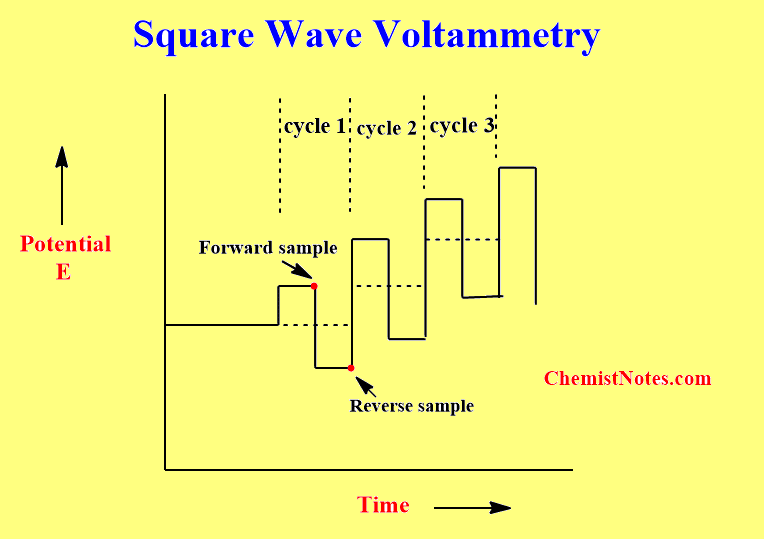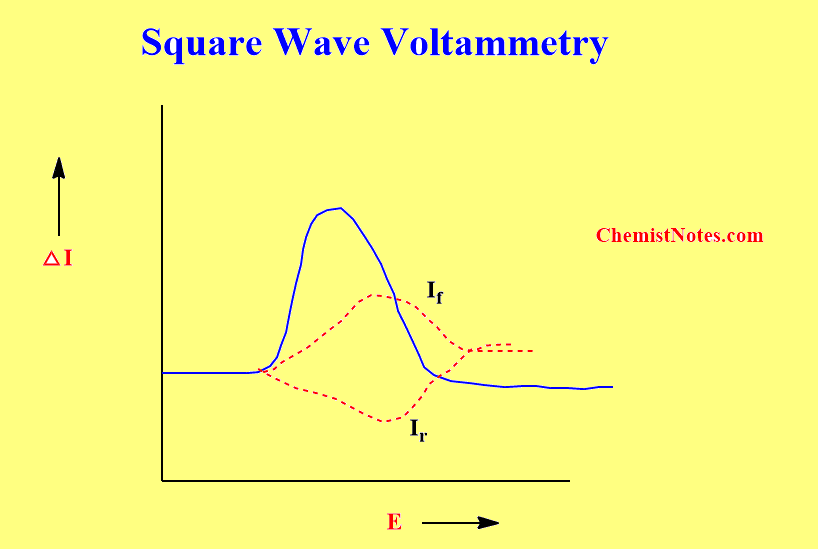Table of Contents
ToggleSquare wave voltammetry (SWV) is a powerful electroanalytical technique that can be applied in both electrokinetic and analytical measurements. The basic principle, excitation signal, advantages along with applications have been discussed in this blog.
What is square wave voltammetry?
Square wave voltammetry is a large amplitude differential technique in which a waveform composed of the symmetrical square wave which is superimposed on a base staircase, is applied to the working electrode. The principle of this technique is described below:
Square wave voltammetry principle
In square wave voltammetry, a waveform consists of a staircase scan, each trend of which is superimposed by a symmetrical double pulse, one in the forward direction and one in the reverse direction.

When square wave potential is applied to the working electrode, electric currents generate. The current is measured twice during each square-wave cycle, once at the end of the forward pulse ( if) and once at the end of the reverse pulse (ir).
The difference between the two measured currents( Δi= if-ir) is plotted versus the base staircase potential, a peak shape voltammogram is obtained which is symmetrical about the half-wave potential and the peak current is proportional to the concentration.

Square wave stripping voltammetry
Square wave stripping voltammetry is commonly applied to the analytical determination of a wide range of trace metals capable of forming an amalgam.
The method has two stages: first, a preconcentration step is performed in which electrodeposition of metal ions in solution leads to the accumulation of metal as an amalgam, by applying either negative or positive potential. In the second step, the electrode potential is swept to reverse potentials either positive or negative, inducing the oxidation of the metal in the mercury electrode.
If preconcentration of the analyte is done by applying cathodic deposition followed by the dissolution of metal ions from the electrode by applying anodic potential, then this technique is termed square wave anodic stripping voltammetry.
Square wave voltammetry vs cyclic voltammetry
The major difference between square wave voltammetry and cyclic voltammetry is the difference in the excitation signal between these two types. In cyclic voltammetry, a periodic triangular potential excitation signal is used to cycle an electrode’s potential between two limits while measuring the resultant current. Whereas, in square wave voltammetry, a waveform consisting of a symmetrical square wave superimposed on a base staircase is applied to the working electrode.
Square wave voltammetry vs differential pulse voltammetry
The main difference between these two electroanalytical methods can be attributed to the types of the excitation signal. In differential pulse voltammetry, a constant but small amplitude potential pulse superimposed on a DC potential ramp is applied during the drop’s lifetime.
Advantages of square wave voltammetry
Some major advantages of square wave voltammetry are described below:
- The high scan rate allows for faster analysis and decreased consumption of electroactive species.
- The oxidation and reduction of the electroactive species at the electrode surface may be measured in the same tests since the current is sampled in both positive and negative going pulses.
- It has a higher sensitivity than a differential pulse that does not involve reverse current.
- It has lower detection limits of up to 10-9 M.
Applications of Square wave voltammetry
Qualitative analysis
Square-wave voltammetric technique’s electroanalytical applications fall into two categories: direct measurements and stripping measurements.
Some ions and chemicals can be directly examined without the accumulation of reactants or products of the electrode reaction. Examples: Arsenic, caffeine, dopamine, lead(II), and so on.
The stripping methods are based either on the accumulation of amalgams and metal deposits or on the adsorptive accumulation of organic substances and metal complexes. Examples: Trace determination of Zinc, Cadmium, Lead, Copper ions, etc.
Qualitative identification of phases
It can be used for the qualitative identification of solid phases which is based on the mechanical immobilization of microparticles of insoluble organic or inorganic compounds on the surface of a solid electrode then used as the working electrode.
Mechanistic and kinetic studies
Square wave voltammetry can be applied for the measurement of kinetic parameters of electrode reactions of adsorbed reactants and products.
Square-wave voltammetry video
Why is square wave voltammetry more sensitive?
Square wave voltammetry is more sensitive because forward as well as reverse current is measured in this technique, which makes it more sensitive than other techniques.






